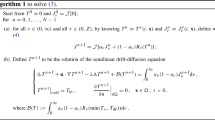Abstract
In [7] we proposed a general numerical approach to the (linear) radiative transfer equation which resulted in a high-dimensional linear system of equations. Using the concept of the generalized mean intensity, the dimension of the system can be drastically diminished, without losing any information. Additionally, the corresponding system matrices are positive definite under appropriate conditions on the choice of the discrete ordinates and, therefore, the classical conjugate gradient-iteration (CG) is converging. In connection with local preconditioners, we develop robust and efficient methods of conjugate gradient type which are superior to the classical approximate Λ-iteration, but with about the same numerical effort. For some numerical tests, which simulate the astrophysically interesting case of radiation of stars in dust clouds, we compare the methods derived and give some examples for their efficiency.
Zusammenfassung
In [7] führten wir einen allgemeinen Zugang zur numerischen Lösung der (linearen) Strahlungstransportgleichung ein, der aber zu sehr hoch dimensionierten Gleichungssystemen führte. Indem wir das Konzept der verallgemeinerten mittleren Intensität verwenden, kann die Dimension drastisch verringert werden, ohne dabei Information zu verlieren. Darüberhinaus werden die Systemmatrizen unter geeigneten Bedingungen an die Wahl der diskreten Ordinaten positiv definit, und das klassische konjugierte Gradientenverfahren (CG) führt zu Konvergenz. In Verbindung mit lokalen Vorkonditionierungstechniken können wir robuste und effiziente Methoden von konjugierten Gradiententyp konstruieren, die sich bei gleichem numerischen Aufwand der klassischen approximativen Λ-Iteration als überlegen erweisen. In numerischen Tests, die den astrophysikalisch interessanten Fall von Sternstrahlung in Staubwolken simulieren, vergleichen wir die verschiedenen hergeleiteten Methoden und geben Beispiele für ihre numerische Effizienz.
Similar content being viewed by others
Explore related subjects
Discover the latest articles, news and stories from top researchers in related subjects.References
Führer, Chr.: A comparative study of finite element solvers for hyperbolic problems with applications to radiative transfer. Technical report SFB 359, 65, University Heidelberg, 1993.
Johnson, C., Pitkäranta, J.: Convergence of a fully discrete scheme for two-dimensional neutron transport. SIAM J. Numer. Anal.20, 951–966 (1983).
Kalkofen, W.: Numerical radiative transfer, Cambridge: Cambridge University Press 1987.
Mihalas, D., Weibel-Mihalas, B.: Foundations of radiation hydrodynamics. Oxford: Oxford University Press, 1984.
Steiner, O.: A rapidly converging temperature correction procedure using operator perturbation. Astron. Astrophys.231, 278–288 (1990).
Turek, S.: Tools for simulating nonstationary incompressible flow via discretely divergence-free finite element models. Int. J. Numer. Meth. Fluids.18, 71–105 (1994).
Turek, S.: An efficient solution technique for the radiative transfer equation. Imp. Comput. Sci. Eng.5, 201–214 (1993).
Turek, S., Wehrse, R.: Spectral appearance of dust enshrouded stars: A combination of a strongly accelerated solution technique with a finite element approach for 2D radiative transfer, Astron. Astrophys. in press (1994).
Van der Vorst, H.: BI-CGSTAB: A fast and smoothly converging variant of BI-CG for the solution of nonsymmetric linear systems. SIAM J. Sci. Stat. Comput.13, 631–644 (1992).
Väth, H. M.: Three-dimensional radiative transfer on a massively parallel computer. Astron. Astrophys.284, 319–331 (1994).
Author information
Authors and Affiliations
Rights and permissions
About this article
Cite this article
Turek, S. A generalized mean intensity approach for the numerical solution of the radiative transfer equation. Computing 54, 27–38 (1995). https://doi.org/10.1007/BF02238078
Received:
Revised:
Issue Date:
DOI: https://doi.org/10.1007/BF02238078




